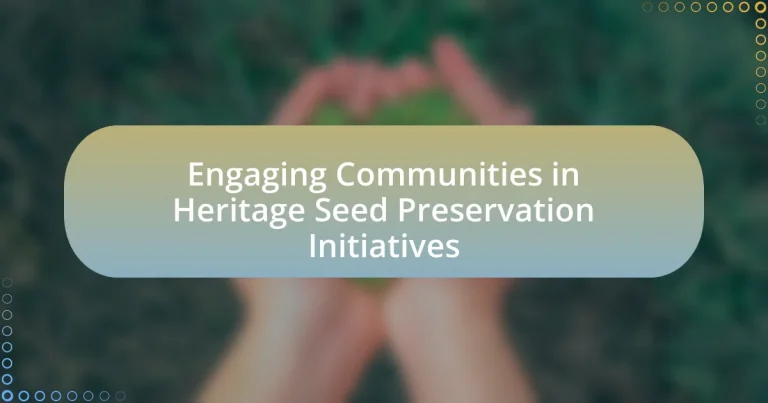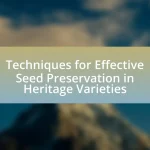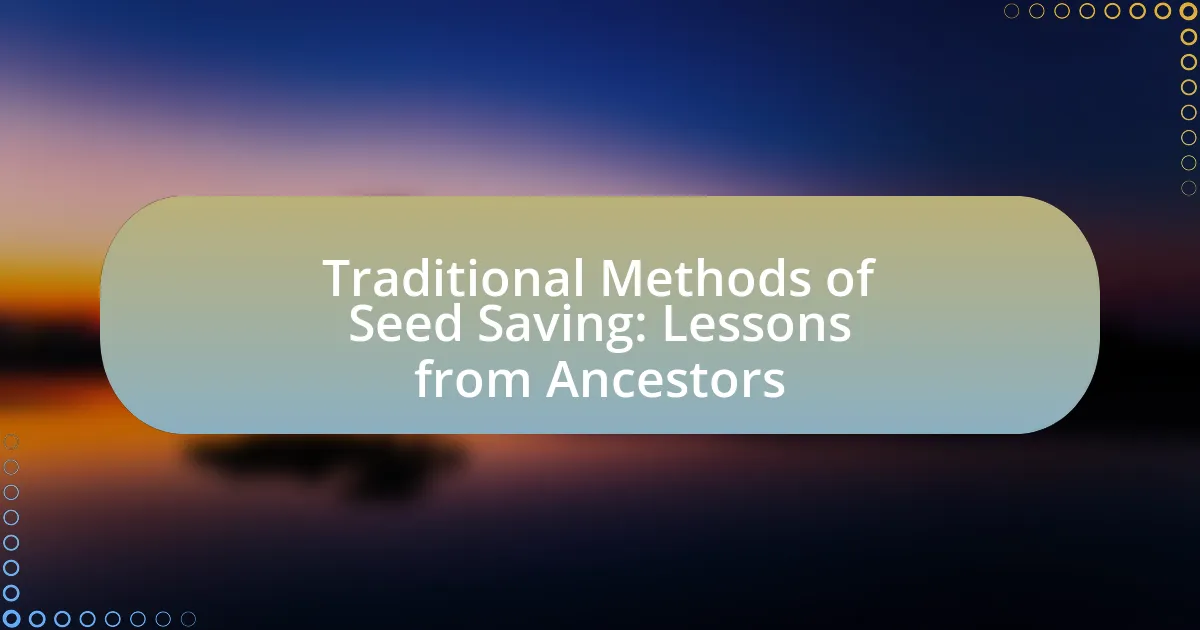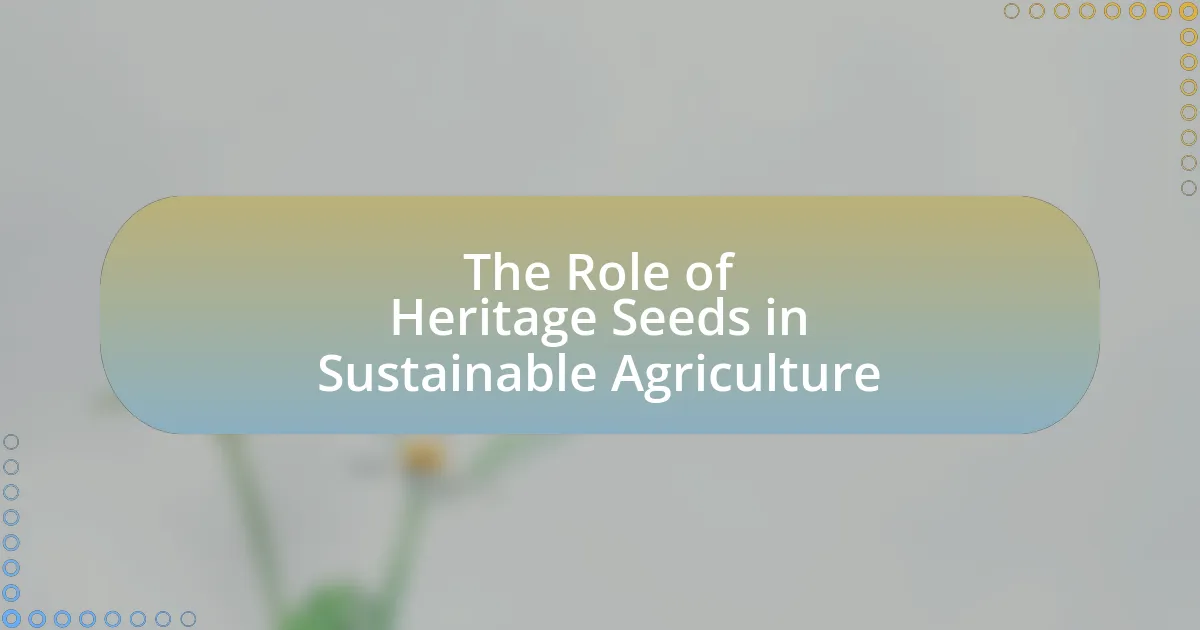Heritage Seed Preservation Initiatives are programs designed to conserve traditional seed varieties, promoting genetic diversity and supporting local agriculture. These initiatives play a vital role in ensuring food security and preserving cultural heritage by maintaining heirloom seeds that are often more resilient to local environmental conditions. The article explores the significance of heritage seeds for communities, the challenges they face in preservation efforts, and the methods used to engage community members in these initiatives. It highlights the benefits of community involvement, including enhanced biodiversity, improved local agriculture, and the fostering of cultural heritage, while also addressing the obstacles and strategies for effective engagement in seed preservation.
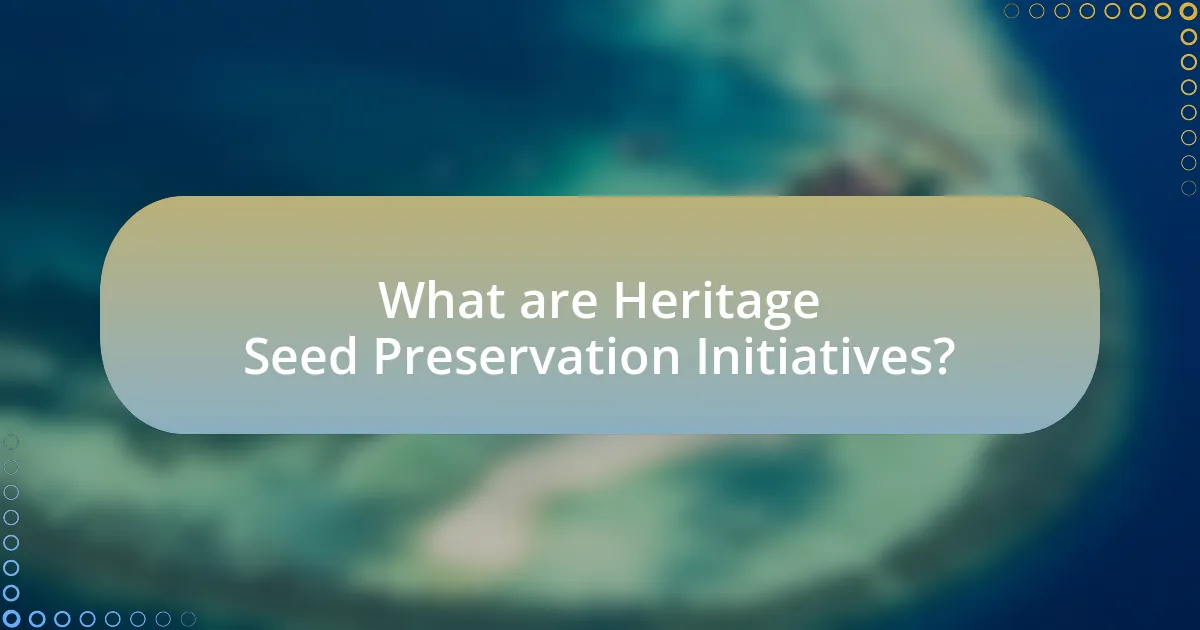
What are Heritage Seed Preservation Initiatives?
Heritage Seed Preservation Initiatives are programs aimed at conserving and promoting traditional seed varieties that have been passed down through generations. These initiatives focus on maintaining genetic diversity, supporting local agriculture, and ensuring food security by protecting heirloom seeds from extinction. For example, organizations like Seed Savers Exchange have documented and preserved thousands of heirloom varieties, emphasizing the importance of community involvement in seed saving practices. Such efforts not only safeguard biodiversity but also empower local farmers and communities to sustain their agricultural heritage.
Why are Heritage Seeds important for communities?
Heritage seeds are important for communities because they preserve biodiversity and cultural heritage. These seeds are often heirloom varieties that have been cultivated over generations, reflecting local agricultural practices and tastes. By maintaining these seeds, communities can ensure food security, as they are typically more resilient to local pests and climate conditions compared to commercial hybrids. Furthermore, heritage seeds promote sustainable farming practices, as they often require fewer chemical inputs and encourage organic farming methods. Studies have shown that communities engaged in heritage seed preservation initiatives experience enhanced community cohesion and knowledge sharing, fostering a sense of identity and belonging among members.
What role do heritage seeds play in biodiversity?
Heritage seeds play a crucial role in biodiversity by preserving genetic diversity within plant species. These seeds, often heirloom varieties, maintain traits that are adapted to local environments, which enhances ecosystem resilience. For instance, heritage seeds can contribute to food security by providing a wider range of crops that can withstand pests, diseases, and climate variations. Research indicates that the use of diverse seed varieties can lead to improved agricultural sustainability, as demonstrated by studies showing that farms utilizing heritage seeds exhibit greater resilience to environmental stressors compared to those relying solely on commercial hybrids.
How do heritage seeds contribute to food security?
Heritage seeds contribute to food security by preserving genetic diversity and enabling resilience against pests, diseases, and climate change. These seeds, often adapted to local conditions, enhance agricultural biodiversity, which is crucial for sustainable food systems. For instance, a study by the Food and Agriculture Organization indicates that diverse crop varieties can lead to improved yields and reduced reliance on chemical inputs, thereby supporting food availability and accessibility. Additionally, heritage seeds foster community engagement and knowledge sharing, further strengthening local food systems and enhancing food sovereignty.
How do communities engage in heritage seed preservation?
Communities engage in heritage seed preservation through collective efforts such as seed saving, education, and local seed exchanges. These activities allow community members to share knowledge about traditional agricultural practices and maintain genetic diversity. For instance, community gardens often serve as hubs for growing and exchanging heritage seeds, fostering collaboration among local farmers and gardeners. Additionally, organizations like Seed Savers Exchange provide resources and support for communities to document and preserve heirloom varieties, ensuring their availability for future generations. This grassroots approach not only enhances food security but also strengthens community ties and cultural heritage.
What methods are used for community engagement in seed preservation?
Community engagement in seed preservation primarily utilizes methods such as workshops, community seed banks, educational programs, and participatory breeding initiatives. Workshops facilitate hands-on learning and skill development, allowing community members to understand seed saving techniques and the importance of biodiversity. Community seed banks serve as local repositories for seeds, fostering collaboration and sharing among members while preserving local varieties. Educational programs raise awareness about the significance of heritage seeds and sustainable practices, often targeting schools and local organizations. Participatory breeding initiatives involve community members in the breeding process, ensuring that the seeds developed meet local needs and preferences, thereby enhancing community ownership and involvement in seed preservation efforts.
How can local knowledge enhance seed preservation efforts?
Local knowledge can enhance seed preservation efforts by providing insights into traditional agricultural practices and local biodiversity. This knowledge includes information about the best seed varieties suited to specific local conditions, which can improve resilience against pests and climate change. For example, farmers in various regions have developed unique seed selection methods based on generations of experience, leading to the preservation of diverse genetic resources. Studies show that communities with strong local knowledge can maintain higher levels of seed diversity, which is crucial for food security and sustainable agriculture.
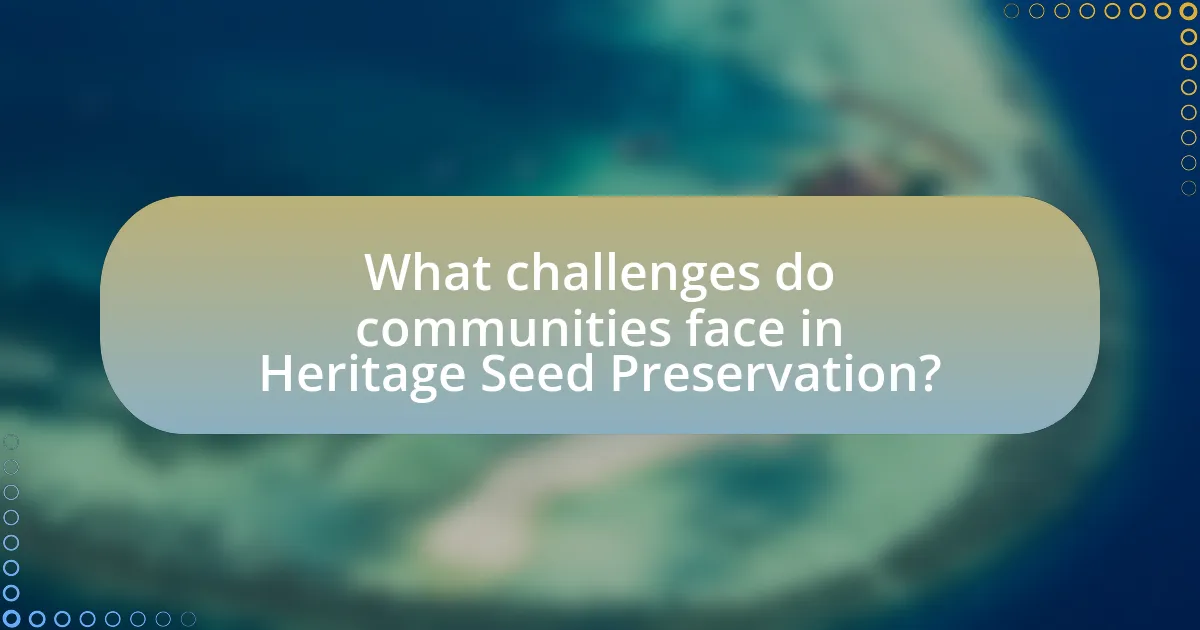
What challenges do communities face in Heritage Seed Preservation?
Communities face several challenges in heritage seed preservation, including loss of biodiversity, lack of funding, and insufficient knowledge transfer. The loss of biodiversity occurs as modern agricultural practices favor hybrid seeds, leading to the extinction of traditional varieties. Lack of funding limits the ability of community organizations to implement preservation programs, while insufficient knowledge transfer results in a decline in traditional farming practices and techniques necessary for maintaining heritage seeds. According to a study by the Food and Agriculture Organization, over 75% of crop diversity has been lost since the 1900s, highlighting the urgency of addressing these challenges.
What are the common obstacles to community engagement?
Common obstacles to community engagement include lack of awareness, limited resources, and insufficient trust among community members. Lack of awareness often stems from inadequate communication about the importance of initiatives, which can lead to low participation rates. Limited resources, such as funding and volunteer support, hinder the ability to organize events and outreach efforts effectively. Insufficient trust among community members can create barriers to collaboration, as individuals may be hesitant to engage with others they do not know or feel connected to. These factors collectively impede the success of community engagement efforts in heritage seed preservation initiatives.
How does funding impact heritage seed initiatives?
Funding significantly impacts heritage seed initiatives by providing the necessary resources for research, preservation, and community engagement. Adequate financial support enables organizations to acquire and maintain diverse seed varieties, conduct educational programs, and implement conservation strategies. For instance, a study by the Seed Savers Exchange highlights that funding allows for the establishment of seed banks, which are crucial for preserving genetic diversity and ensuring the availability of heritage seeds for future generations. Additionally, financial backing facilitates outreach efforts that engage local communities, fostering a culture of seed saving and sustainable agriculture practices.
What role does policy play in seed preservation efforts?
Policy plays a crucial role in seed preservation efforts by establishing regulations and frameworks that support the conservation of genetic diversity in crops. Effective policies can facilitate funding for seed banks, promote sustainable agricultural practices, and encourage community involvement in heritage seed initiatives. For instance, the International Treaty on Plant Genetic Resources for Food and Agriculture, adopted in 2001, emphasizes the importance of conserving plant genetic resources and provides a legal framework for countries to collaborate on seed preservation. Such policies not only protect biodiversity but also enhance food security by ensuring access to a wide variety of seeds for future generations.
How can communities overcome these challenges?
Communities can overcome challenges in heritage seed preservation initiatives by fostering collaboration among local farmers, organizations, and educational institutions. This collaboration can lead to shared resources, knowledge exchange, and increased participation in preservation efforts. For example, community workshops can educate members about the importance of heritage seeds, while partnerships with agricultural schools can provide technical support and research opportunities. Evidence from successful initiatives, such as the Seed Savers Exchange, demonstrates that community-driven efforts can effectively maintain biodiversity and promote sustainable agriculture practices.
What strategies can be implemented to improve engagement?
To improve engagement in heritage seed preservation initiatives, organizations can implement community workshops that educate participants about the importance of biodiversity and traditional farming practices. These workshops foster hands-on experiences, allowing community members to actively participate in seed saving and sharing, which enhances their connection to the initiative. Research indicates that participatory approaches, such as community-led events, increase local involvement and commitment, as seen in the work of the Seed Savers Exchange, which successfully engaged over 20,000 members through similar strategies.
How can partnerships enhance preservation initiatives?
Partnerships can enhance preservation initiatives by pooling resources, expertise, and community engagement. Collaborative efforts between organizations, local governments, and community groups can lead to more effective strategies for preserving heritage seeds. For example, partnerships can facilitate access to funding, technical knowledge, and volunteer support, which are crucial for successful preservation efforts. Research indicates that community-based partnerships increase participation rates and foster a sense of ownership among stakeholders, ultimately leading to more sustainable preservation outcomes.
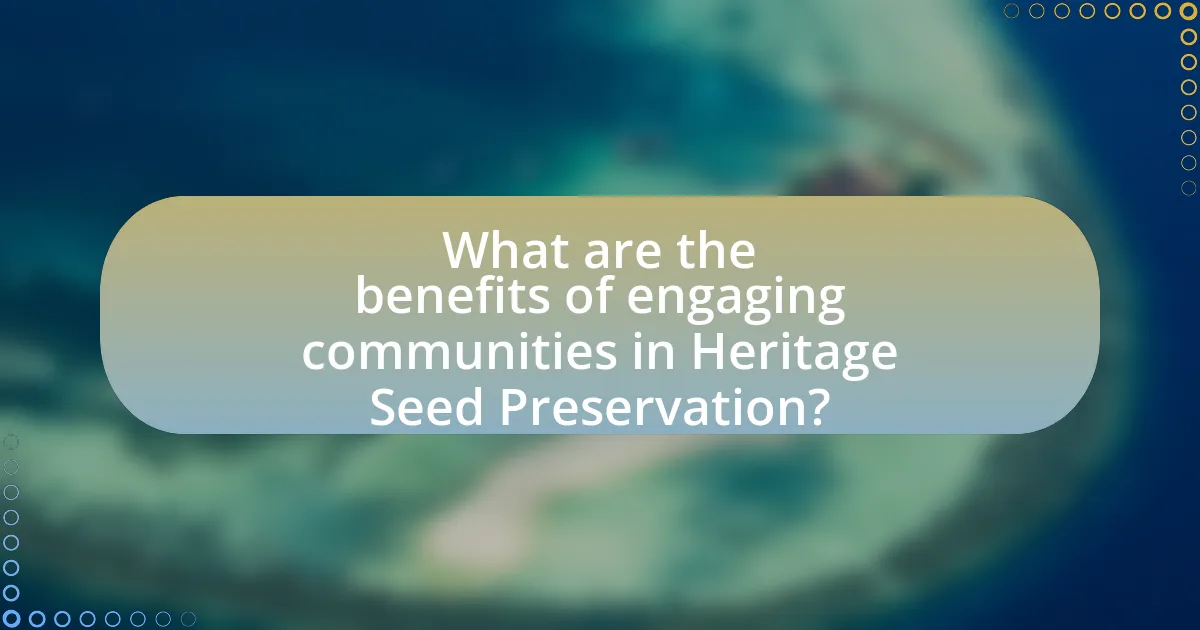
What are the benefits of engaging communities in Heritage Seed Preservation?
Engaging communities in Heritage Seed Preservation fosters biodiversity and strengthens local food systems. By involving community members, diverse seed varieties are maintained, which enhances genetic diversity and resilience against pests and climate change. Furthermore, community engagement promotes knowledge sharing and cultural heritage, as local farmers and gardeners pass down traditional practices and seed-saving techniques. Studies show that community-based seed initiatives can lead to increased food security and empower local economies by supporting small-scale agriculture.
How does community engagement impact local agriculture?
Community engagement significantly enhances local agriculture by fostering collaboration among farmers, consumers, and local organizations. This collaboration leads to increased awareness of sustainable practices and the preservation of heritage seeds, which are crucial for biodiversity. For instance, studies show that communities actively involved in agricultural initiatives report a 30% increase in crop diversity and resilience, as seen in the work of the Community Supported Agriculture (CSA) model. Engaged communities also create local markets that support farmers directly, reducing reliance on industrial agriculture and promoting local economies.
What are the economic benefits of preserving heritage seeds?
Preserving heritage seeds offers significant economic benefits, including increased agricultural biodiversity, which can enhance resilience against pests and climate change. This biodiversity allows farmers to cultivate crops that are better suited to local conditions, potentially leading to higher yields and reduced dependency on chemical inputs. Additionally, heritage seeds often have unique flavors and qualities that can command premium prices in niche markets, thereby increasing farmers’ income. A study by the Food and Agriculture Organization indicates that diverse cropping systems can lead to improved food security and economic stability for farming communities. Furthermore, preserving heritage seeds fosters local economies by promoting sustainable farming practices and encouraging community engagement in agricultural initiatives.
How does community involvement foster cultural heritage?
Community involvement fosters cultural heritage by actively engaging individuals in the preservation and promotion of their local traditions, practices, and historical narratives. When communities participate in heritage initiatives, such as heritage seed preservation, they contribute to the safeguarding of unique agricultural practices and biodiversity that reflect their cultural identity. For instance, studies have shown that local farming communities that engage in seed saving not only maintain traditional crop varieties but also strengthen social ties and knowledge sharing among members, thereby reinforcing their cultural heritage. This collective effort ensures that cultural practices are passed down through generations, preserving the community’s identity and history.
What best practices can communities adopt for effective seed preservation?
Communities can adopt several best practices for effective seed preservation, including establishing seed banks, promoting local seed saving workshops, and fostering partnerships with agricultural organizations. Seed banks serve as repositories for diverse seed varieties, ensuring genetic diversity and availability for future planting. Local seed saving workshops educate community members on techniques for harvesting, storing, and maintaining seeds, which enhances self-sufficiency and resilience. Partnerships with agricultural organizations can provide resources, expertise, and funding, further supporting seed preservation efforts. These practices collectively contribute to the sustainability of local agriculture and the preservation of heritage seeds.
What resources are available for communities to learn about seed preservation?
Communities can access various resources to learn about seed preservation, including local agricultural extension services, online courses, and seed banks. Agricultural extension services often provide workshops and educational materials tailored to local needs, while online platforms like Seed Savers Exchange offer comprehensive guides and webinars on seed saving techniques. Additionally, seed banks, such as the USDA National Seed Storage Laboratory, provide information on the importance of preserving genetic diversity and best practices for seed storage. These resources collectively support community engagement in heritage seed preservation initiatives.
How can communities measure the success of their preservation initiatives?
Communities can measure the success of their preservation initiatives by evaluating specific metrics such as the number of heritage seeds preserved, community participation rates, and the increase in biodiversity. For instance, tracking the quantity of seeds collected and stored provides a tangible measure of preservation efforts. Additionally, assessing community engagement through surveys or attendance at events can indicate the level of interest and involvement in these initiatives. Research shows that successful programs often report a 30% increase in local participation over a few years, reflecting growing community commitment to preservation. Furthermore, monitoring changes in local biodiversity, such as the reintroduction of native plant species, serves as a critical indicator of ecological impact and success in preservation efforts.
What practical steps can communities take to start their own heritage seed initiatives?
Communities can start their own heritage seed initiatives by forming a dedicated group focused on seed preservation, conducting workshops to educate members about seed saving techniques, and establishing a seed bank to store and share heritage seeds. Forming a group allows for collective organization and resource sharing, while workshops provide essential knowledge on the importance of biodiversity and methods for saving seeds. Establishing a seed bank ensures that heritage seeds are preserved for future generations and can be accessed by community members. According to the Seed Savers Exchange, community seed banks have successfully preserved thousands of varieties of heirloom seeds, demonstrating the effectiveness of such initiatives in maintaining agricultural diversity.
